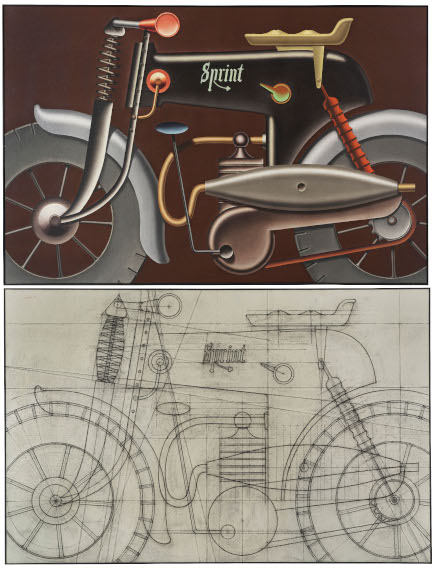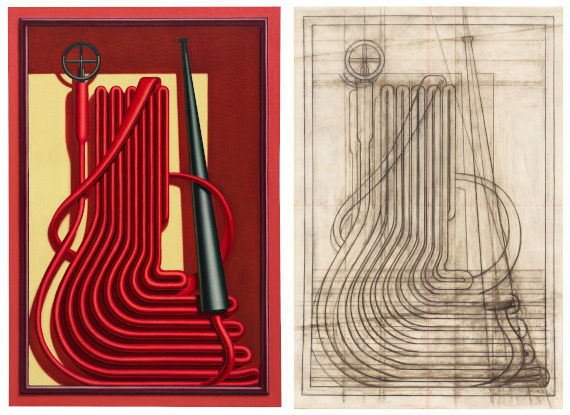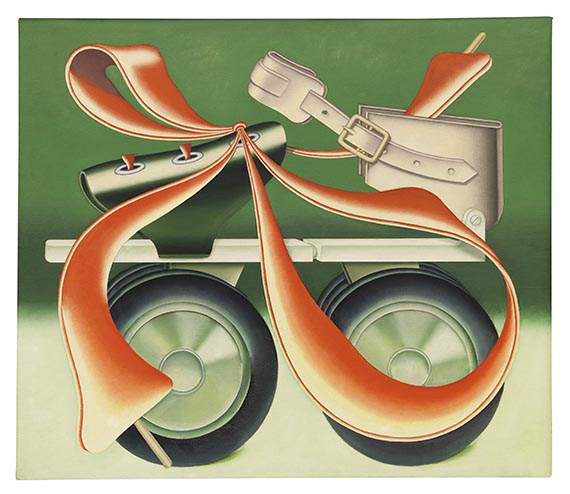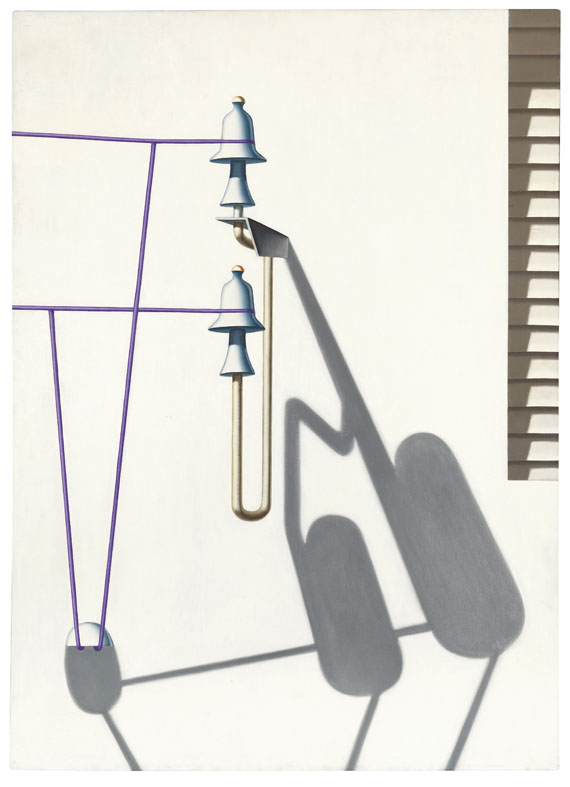54
Konrad Klapheck
Der Selbstsüchtige, 1964.
Oil on canvas
Estimate:
€ 100,000 - 150,000
$ 110,000 - 165,000
Der Selbstsüchtige. 1964.
Oil on canvas.
Signed, dated and with a direction arrow on the reverse. Titled on the stretcher. 80 x 66 cm (31.4 x 25.9 in). [JS].
• “Der Selbstsüchtige” (The Selfish Man) is a captivating reflection of the dark side of human nature, presented in consummate “hyper representationalism” and subtly nuanced colors.
• Klapheck is recognized as the inventor and master of the “machine picture,” which he sees as a mirror of human existence.
• Klapheck's oeuvre, which solely comprises character objects, anticipated elements of Pop Art and Photorealism as early as the 1950s.
• From his best creative period: many paintings from the 1960s are museum-owned today.
• The work featured in the early Klapheck exhibition at the Kestner-Gesellschaft in Hanover in 1966 and has since been part of a private collection in the Rhineland.
The painting is registered in the artist's archive under the work number 139. We are grateful to Rabbi Prof. Dr. Elisa Klapheck for her kind support in cataloging this lot.
PROVENANCE: Galerie Rudoph Zwirner, Essen (directly from the artist).
Private collection, Rhineland (acquired from the above in 1965).
EXHIBITION: Konrad Klapheck, Kestner-Gesellschaft Hanover, November-December 1966, p. 35, cat. no. 139 (not illustrated).
Konrad Klapheck, quoted from: Mensch und Maschinen. Bilder von Konrad Klapheck, Bonn 2006, p. 85
Called up: December 6, 2024 - ca. 18.46 h +/- 20 min.
Oil on canvas.
Signed, dated and with a direction arrow on the reverse. Titled on the stretcher. 80 x 66 cm (31.4 x 25.9 in). [JS].
• “Der Selbstsüchtige” (The Selfish Man) is a captivating reflection of the dark side of human nature, presented in consummate “hyper representationalism” and subtly nuanced colors.
• Klapheck is recognized as the inventor and master of the “machine picture,” which he sees as a mirror of human existence.
• Klapheck's oeuvre, which solely comprises character objects, anticipated elements of Pop Art and Photorealism as early as the 1950s.
• From his best creative period: many paintings from the 1960s are museum-owned today.
• The work featured in the early Klapheck exhibition at the Kestner-Gesellschaft in Hanover in 1966 and has since been part of a private collection in the Rhineland.
The painting is registered in the artist's archive under the work number 139. We are grateful to Rabbi Prof. Dr. Elisa Klapheck for her kind support in cataloging this lot.
PROVENANCE: Galerie Rudoph Zwirner, Essen (directly from the artist).
Private collection, Rhineland (acquired from the above in 1965).
EXHIBITION: Konrad Klapheck, Kestner-Gesellschaft Hanover, November-December 1966, p. 35, cat. no. 139 (not illustrated).
Konrad Klapheck, quoted from: Mensch und Maschinen. Bilder von Konrad Klapheck, Bonn 2006, p. 85
Called up: December 6, 2024 - ca. 18.46 h +/- 20 min.
Unparalleled in its perfection, the fascinating and, at the same time, unsettling painterly work that the German artist Konrad Klapheck has left to posterity is truly incomparable. With the first paintings of typewriters made at just 20 in 1955, he had already discovered his characteristic pictorial language. Two years later, he created his first sewing-machine painting, “Die gekränkte Braut” (The Wronged Bride), which he dedicated to his future wife Lilo. In retrospect, Klapheck described this painting as a kind of artistic awakening when he wrote: “Since painting this picture, I knew that machines could represent all human relationships.” (Quoted from ex. cat. Konrad Klapheck, Museum Boymans van Beuningen 1974, p. 46). Henceforth, Klapheck would be considered an inventor and undisputed master of the psychoanalytical machine image. His objects, placed on the canvas in perfect super-representationalism and with a zoom-like focus, have a fascinating 'surreal-real' quality. Regarding content, Klapheck's 'character objects' are accumulated symbols of human existence. The accomplishments that Klapheck made with his unique style seem almost paradoxical: Klapheck made man the central theme of his oeuvre in an entirely deserted, super-representational style. Klapheck once described the human nature of his “super-representational” objects as follows:“[..] Sure, from time to time, people would ask me: Well, your children are so adorable, why don't you paint them? And why don't you show people? Back then, I always thought: But people are at the center of my work; they are the subject!” (K. Klapheck, 2002, quoted from: Klapheck. Bilder und Texte, Munich 2013, p. 114). Klapheck's suggestive titles range from household objects with female-maternal associations, such as “Die Supermutter” (Super Mum, 1969, private collection, Europe) or “Die Soldatenbräute” (Soldiers Brides, 1967, Museum Ludwig, Cologne), to machine images characterized by a political-authoritarian appeal like “Der Chef” (The BOss, 1965, Museum Kunstpalast, Düsseldorf), “Der Diktator” (The Dictator, 1967/70, Museum Ludwig, Cologne) or “Der Krieg” (The War, 1965, Kunstsammlungen Nordrhein Westfalen, Düsseldorf) to pictures of bicycles, motorcycles and roller skates in which Klapheck brings back memories of his youth and that of his children. Klapheck's characterization in “Der Selbstsüchtige” from 1964 is equally fascinating. It is based on the robust object quality of a yarn winder. The bulky black body of the device emerges from the pictorial diagonal with power and self-confidence. The yarn winder does not produce anything when in operation; its sole purpose is to rewind the yarn from one spool to another. Thus, “Der Selbstsüchtige” appears to be preoccupied with its existence in an almost morbid way, becoming a silent monument that has lost no relevance in the age of social media. This is yet another piece that demonstrates the perfection of Klapheck's painting, which is cool and deserted, dedicated solely to the human being. Klapheck's fascinating “super-representationalism” and technically perfect painting is characterized by a highly associative density that provides visual stimulus for complex and subjective emotional sensations. [JS]
54
Konrad Klapheck
Der Selbstsüchtige, 1964.
Oil on canvas
Estimate:
€ 100,000 - 150,000
$ 110,000 - 165,000
Buyer's premium, taxation and resale right compensation for Konrad Klapheck "Der Selbstsüchtige"
This lot can be purchased subject to differential or regular taxation, artist‘s resale right compensation is due.
Differential taxation:
Hammer price up to 800,000 €: herefrom 32 % premium.
The share of the hammer price exceeding 800,000 € is subject to a premium of 27 % and is added to the premium of the share of the hammer price up to 800,000 €.
The share of the hammer price exceeding 4,000,000 € is subject to a premium of 22 % and is added to the premium of the share of the hammer price up to 4,000,000 €.
The buyer's premium contains VAT, however, it is not shown.
Regular taxation:
Hammer price up to 800,000 €: herefrom 27 % premium.
The share of the hammer price exceeding 800,000 € is subject to a premium of 21% and is added to the premium of the share of the hammer price up to 800,000 €.
The share of the hammer price exceeding 4,000,000 € is subject to a premium of 15% and is added to the premium of the share of the hammer price up to 4,000,000 €.
The statutory VAT of currently 19 % is levied to the sum of hammer price and premium. As an exception, the reduced VAT of 7 % is added for printed books.
We kindly ask you to notify us before invoicing if you wish to be subject to regular taxation.
Calculation of artist‘s resale right compensation:
For works by living artists, or by artists who died less than 70 years ago, a artist‘s resale right compensation is levied in accordance with Section 26 UrhG:
4 % of hammer price from 400.00 euros up to 50,000 euros,
another 3 % of the hammer price from 50,000.01 to 200,000 euros,
another 1 % for the part of the sales proceeds from 200,000.01 to 350,000 euros,
another 0.5 % for the part of the sale proceeds from 350,000.01 to 500,000 euros and
another 0.25 % of the hammer price over 500,000 euros.
The maximum total of the resale right fee is EUR 12,500.
The artist‘s resale right compensation is VAT-exempt.
Differential taxation:
Hammer price up to 800,000 €: herefrom 32 % premium.
The share of the hammer price exceeding 800,000 € is subject to a premium of 27 % and is added to the premium of the share of the hammer price up to 800,000 €.
The share of the hammer price exceeding 4,000,000 € is subject to a premium of 22 % and is added to the premium of the share of the hammer price up to 4,000,000 €.
The buyer's premium contains VAT, however, it is not shown.
Regular taxation:
Hammer price up to 800,000 €: herefrom 27 % premium.
The share of the hammer price exceeding 800,000 € is subject to a premium of 21% and is added to the premium of the share of the hammer price up to 800,000 €.
The share of the hammer price exceeding 4,000,000 € is subject to a premium of 15% and is added to the premium of the share of the hammer price up to 4,000,000 €.
The statutory VAT of currently 19 % is levied to the sum of hammer price and premium. As an exception, the reduced VAT of 7 % is added for printed books.
We kindly ask you to notify us before invoicing if you wish to be subject to regular taxation.
Calculation of artist‘s resale right compensation:
For works by living artists, or by artists who died less than 70 years ago, a artist‘s resale right compensation is levied in accordance with Section 26 UrhG:
4 % of hammer price from 400.00 euros up to 50,000 euros,
another 3 % of the hammer price from 50,000.01 to 200,000 euros,
another 1 % for the part of the sales proceeds from 200,000.01 to 350,000 euros,
another 0.5 % for the part of the sale proceeds from 350,000.01 to 500,000 euros and
another 0.25 % of the hammer price over 500,000 euros.
The maximum total of the resale right fee is EUR 12,500.
The artist‘s resale right compensation is VAT-exempt.




 Lot 54
Lot 54 






